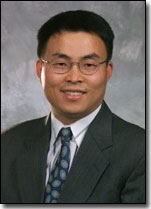
2005 IEEE International Conference on Acoustics, Speech, and Signal Processing
March 18-23, 2005 • Pennsylvania Convention Center/Marriott Hotel • Philadelphia, PA, USA
ICASSP
30th Anniversary
Tutorial TUT-8: Distributed source coding: theory, algorithms, and applications
Instructors
Z. Xiong; Texas A&M University
Time & Location
Saturday, March 19, 09:00 - 12:00, Location: CC: Room 113-B
Abstract
What is about? Distributed source coding (DSC) refers to the compression of the outputs of two or more physically separated sources. The catch is that the sources do not communicate with each other (hence distributed coding). These sources send their compressed outputs to a central point (e.g., the base station) for joint decoding. DSC is related to the CEO problem and is part of network information theory. Driven by a host of emerging applications (e.g., sensor networks and wireless video), DSC has recently become a very active research area – more than 30 years after Slepian and Wolf laid its theoretical foundation.
While a unified theory of network information flow still remains elusive, recent developments in DSC algorithms are truly causes for excitement. For example, practical approaches to DSC started appearing in the literature in 1999. In particular, we offered the first practical solution to the Slepian-Wolf problem for binary memoryless sources using advanced channel codes such as LDPC codes, achieving performance results very close to the theoretical limit. For the more general Wyner-Ziv coding problem, we present a Slepian-Wolf coded nested quantization paradigm that performs only 0.2 dB away from the Wyner-Ziv rate-distortion function with trellis-coded quantization and ideal Slepian-Wolf coding. Thus we are approaching the theoretical performance limit of DSC and the stage is set for practical applications of DSC to sensor networks and related areas (e.g., error-robust video coding).
The aim of the tutorial is to keep attendees abreast of the latest results and stimulate new research on DSC through cross-fertilization among researchers in the signal processing community.
Why is this topic import? DSC belongs to the topic of distributed signal processing. It is said that the term DSP in digital signal processing should be given new meaning in the sense that the D in DSP now could be construed as “distributed.” It is thus important for ICASSP attendees to know the new meaning of DSP (distributed signal processing) and the latest developments in this area.
Who should attend? This is a basic tutorial that is tailored to both graduate students and researchers in academia/industry.
Overview of the tutorial session: This half-day tutorial will provide a comprehensive coverage of the theory, algorithmic code designs and application examples of DSC. Both our work and relevant research efforts by other groups will be highlighted. An outline of the topics follows below.
- Introduction
- Classic lossless source coding
- Near-lossless source coding based on channel codes
- Slepian-Wolf coding, Wyner-Ziv coding and Multiterminal source coding
- Theoretical background
- The Slepian-Wolf Theorem and the Slepian-Wolf rate region
- Wyner-Ziv coding and the Wyner-Ziv rate-distortion function
- Successive Wyner-Ziv coding
- Multiterminal source coding: The inner and outer rate regions
- Distributed joint source-channel coding: Separation Theorems
- Code designs
- Slepian-Wolf code design: The optimal syndrome-based approach
- Wyner-Ziv code design: Slepian-Wolf coded quantization (SWCQ)
- Multiterminal source code design
- Distributed source-channel code design: The parity-based approach
- Distributed video coding
- Slepian-Wolf coding of two correlated images
- Wyner-Ziv video coding
- Distributed joint source-channel coding of video
Presenter Information

Zixiang Xiong (S'91-M'96-SM'02) received the Ph.D. degree in Electrical Engineering in 1996 from the University of Illinois at Urbana-Champaign. From 1997 to 1999, he was with the University of Hawaii. Since 1999, he has been with the Department of Electrical Engineering at Texas A&M University, where he is an Associate Professor. He spent the summers of 1998 and 1999 at Microsoft Research, Redmond, WA and the summers of 2000 and 2001 at Microsoft Research in Beijing. His current research interests are distributed source coding, joint source-channel coding and genomic signal processing.
Dr. Xiong received an NSF Career Award in 1999, an ARO Young Investigator Award in 2000 and an ONR Young Investigator Award in 2001. He also received faculty fellow awards in 2001, 2002 and 2003 from Texas A&M University. He is currently an associate editor for the IEEE Trans. on Circuits and Systems for Video Technology, the IEEE Trans. on Signal Processing, and the IEEE Trans. on Image Processing.